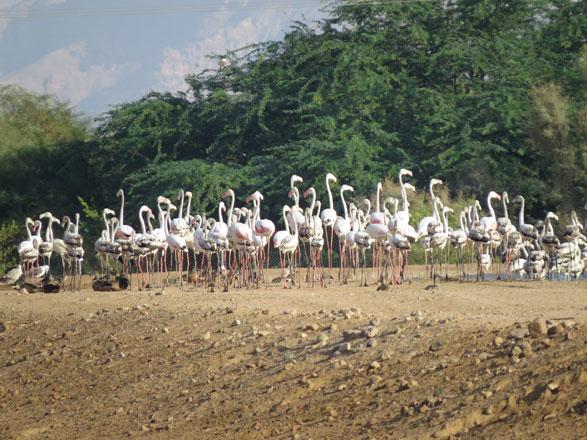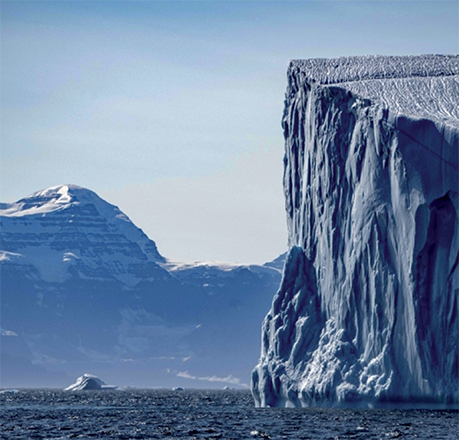You are here
The story about Earth’s power and fragility
Dec 29,2020 - Last updated at Dec 29,2020

What was the idea behind A Perfect Planet?
Huw Cordey and I felt strongly that nobody had ever really done justice to the power and beauty of the natural forces that shape all life on our planet. There have, of course, been many weather shows, but even these never reached the quality and ambition of this blue chip landmark series. We were attracted to the fact that most people see the forces of nature, such as volcanic activity, as negative and destructive. However, this could not be further from the truth. We also liked the idea of telling the story of our planet’s forces through the eyes of the animals and plants whose lives they dominate. Finally, we felt this series could not have been timelier. Everyone is questioning whether mankind has upset “A Perfect Planet” and we were determined that our last episode would answer this question in a powerful and honest way.
How does A Perfect Planet move forward from previous BBC natural history series?
Combining the very best natural history footage with powerful images of the forces of nature has never been attempted in this way before. We are proud that big global stories have been told through the lives of engaging animal characters. The environmental narrative runs throughout the whole series but the final episode has to be the most powerful environmental message ever in any natural history landmark series.
What does it mean to have Sir David Attenborough present
A Perfect Planet?
Sir David’s skill as a communicator goes without question. It comes with an authority that was critical to this series. This is particularly true of the final episode where, his presence in vision, adds so much to this complex and difficult message.
What is your favourite moment in the whole series?
There are so many wonderful sequences, I find it almost impossible to choose one favourite moment. However, if pressed, it would have to be the extraordinary spectacle of flamingos nesting on Lake Natron that opens episode one. It is one of the most extraordinary survival stories in nature, absolutely beautifully shot. It combines epic aerial images, captured as never seen before, with a really dramatic narrative and intimate character portraits.
Interview with Huw Cordey — series producer
What was the idea behind A Perfect Planet?
The idea behind the series was to show how the forces of nature — volcanoes, sunlight, ocean currents and weather — have nurtured the great diversity of life we have on our planet.
There have been many natural history series focussing on animal behaviour and habitats but this is the first to combine earth sciences, and a global perspective of our planet, and blue chip natural history — revealing not just powerful and intimate animal stories but giving the audience a much greater understanding of how the world works.
We are the only known planet in the Universe with life — a fact that, on its own, would easily justify the description of ‘perfect’ — but none of it would have got started without a lot of cosmic fortune: Earth is the perfect distance from the sun, with the perfect tilt of 23.5 degrees. It has the ideal spin and a decent sized moon to stop us wobbling on our axis. But for life to proliferate as it has, our Goldilocks planet needed the perfect balance of natural forces that form the basis of this series.
Without volcanoes, for instance, we would have no breathable atmosphere, no oceans and no dry land. Our weather distributes freshwater around the globe; ocean currents circulate essential nutrients, and energy from the sun powers our living world and is a vital ingredient for the most important chemical reaction on the planet — photosynthesis. And for the last ten thousand years, these forces have provided warmth and stability.
A Perfect Planet shows how these forces have shaped life on earth, from hundreds of thousands of lesser flamingos using a toxic volcanic lake to breed, to fire ants forming rafts in the Amazon’s flooded forest; from the wood frog that freezes solid like a block of ice every winter tiny to the fifty million red crabs of Christmas Island, which, on the onset of the Australian wet season, migrate to the coast where they cast trillions of eggs into the sea.A Perfect Planet is a celebration of our unique planet.
What is the format
of the series?
A Perfect Planet is a five part series — the first four episodes look at the natural forces; volcanoes, the sun, weather and ocean currents, and the last in the series focuses on the human force and our impact on the natural world.
Why do you think that it’s important that humans are included in this series?
This series would have felt incomplete without including the human force and our impact on the planet. As Sir David Attenborough says at the beginning of the episode, “This is the most important story of our times”.
There’s no denying that we are a powerful force — the most numerous mammal species after the brown rat — but our activity is now threatening the natural forces that our planet depends on. Indeed, our impact is now so great that scientists have suggested we have entered a new geological era, “the Anthropocene” — a period where human activity has been the dominant influence on the environment.
We now release more carbon dioxide, through our burning of fossil fuels, than all the world’s volcanoes — and this gas is destabilising our weather, upsetting ocean currents and making our planet warmer. The consequences of this, if left unchecked, would be disastrous — not just for humanity but also for our great diversity of species. At the moment, we are losing species at a rate of more than 1000 times faster than would be considered normal. It’s why many scientists now believe that we are in a sixth mass extinction.
This episode shows how and why we have got to this position — but, and more importantly, it also reveals what we need to do to reverse the damage. The answer, appropriately, can be found in our natural forces, since green energy — wind, solar and thermal — can easily provide humanity with all the energy we require.
What were the main
challenges in this series?
The biggest challenge for any landmark series is how to raise the bar on what has been done previously. The audience has a huge expectation for each blue chip natural history series and to succeed they must feel fresh and surprising.
We believed we had a very fresh idea but we still needed to tell engaging animal stories as never before. This required taking a lot of risks; for instance, trying to film the flamingo breeding spectacle on Lake Natron in Tanzania, which occurs only once in five years (Lake Natron is also one of the most demanding filming locations both logistically and physically — being one of the most toxic bodies of water on the planet, as well as remote; or, filming the nesting iguanas at the bottom of Fernandina’s active volcano, in the Galapagos. More people have been in space than the bottom of this volcanic crater and the scale of the expedition to film the behaviour was one that’s rarely been attempted in the Galapagos.
Covering the entire globe, the whole production was a massive logistical exercise as many of the locations were in remote parts of the world and often involved expedition scale planning.
Did you film any new species?
The vampire finches we filmed for the Volcano episode were only officially recognised as a new species in 2018. They live on a very isolated, uninhabited island in the Galapagos and nobody has filmed them for TV in over 30 years. Every episode in the series has animal behaviour that has never been filmed before; such as the black tip reef sharks beaching themselves to catch baitfish in Lizard Island, flamboyant cuttlefish mating and laying eggs, the cave seeking giant tortoises of Aldabra, white wolves hunting musk oxen in the Polar night, and huge Nile crocodiles launching themselves out of the water to predate flocks of drinking quelea and bee eaters.
New developments in technology — particularly drones, which are now smaller, quieter and stay up for longer — has allowed us to film other stories in ways not possible before, from the fishing bears in Kamchatka to the spectacle of nesting lesser flamingos on Lake Natron and the epic trek of their chicks across the salt encrusted lake, and the Gobi Desert’s Bactrian camels, one of the rarest large mammals on the planet.
How has wildlife filming changed in the last decade?
The technology has certainly changed for the better meaning we can attempt things that simply weren’t possible before. Cameras, for instance, are significantly better in low light than they were a decade ago making filming in places like jungles much easier. Lenses have also got more powerful. High quality remote cameras have allowed us to enter the world of animals that were previously either too rare or too sensitive to film in conventional ways. And there have been huge developments in moving camera technology from hand held gyro stabilised systems to sophisticated gimbals that can steady the action filmed on the end of long lenses. And then there are the drones. Ten years ago, battery technology for remote controlled aerial systems would have allowed you just a few minutes of filming time, and the drones were noisy and not very steady. Now, you can keep a drone in the air for as much as 30 minutes. They are smaller, a lot quieter (so much less disturbing to the animals you are trying to film) and are significantly more stable in the air — so shots are mostly very steady.
However, what hasn’t changed is the audience expectation. People come to blue chip, landmark shows to be awed, inspired and surprised. It may be the only natural history series they watch all year but they won’t stay if the programmes feel familiar. So, while developments in technology have allowed us to shine a light on animals in new and fresh ways, it is still important to find completely new species and behaviour. This may feel like a growing challenge but it’s always amazing that with every new series a raft of new and surprising stories emerge. In my opinion, there’s no sign of this changing in the foreseeable future!
The last decade has also brought a number of changes in style and presentation. At the moment, there is an emphasis on intimate character led stories, animal dramas, if you like. It’s been an exciting time as this approach pushes the boundaries of creativity.
What is your favourite
moment in the series?
My favourite moment in the series would be the aerial footage of the lesser flamingos nesting on Lake Natron. This event only happens once every five years or so, and then with virtually no notice, so just capturing the spectacle on film was a huge achievement for the team.But the drone shots of thousands of breeding flamingos on the otherworldly Lake Natron, with the towering volcano of OlDoinyoLengai in the background, are something else — Rembrandts as Alastair Fothergill would say!
Related Articles
AMMAN — Bird observers are having the chance to experience watching flamingos up-close as they pick their meal from seawater at the Aqaba Bi
The steam and heat from volcanoes allowed species of plants and animals to survive past ice ages, a study showed Tuesday, offering help for scientists dealing with climate change.
LOS ANGELES — “Life on Our Planet”, the new natural history series from Netflix and Steven Spielberg, sets out to tell the entire, dramatic


















